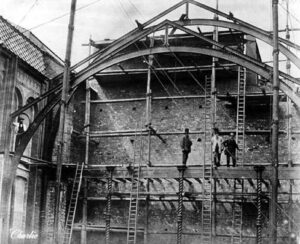
Scaffolding, in some form, has been in use since man began building upwards with large, momentous structures and buildings and although it has become commonplace in domestic and commercial construction, its origins stretch back thousands of years.
The use of scaffolding goes back so far in fact, there are multiple artefacts that show how the Egyptians used wood and rope to help erect the great pyramids
When was the earliest recorded use of scaffolding?
Located in Dordogne, Southern France there are a series of underground chambers known as Lascaux caves and these caves possess some of the most interesting parts of human history. Beautifully hand painted cave walls with intricate carvings and drawings of animals, humans and abstract symbols.
The drawings can even be found high up on the ceilings of the caves, which would have been impossible to reach without tools or a support mechanism to help them stand and paint. Archaeologists have discovered little holes and sockets can be round around the paintings which with strong confidence can be said these would have been some form of archaic scaffolding.

Scaffolding in ancient Egypt
As mentioned previously at the start of this blog, there have been an array of artefacts found from ancient egypt which prove the use of archaic scaffolding. Far from today’s commercial and domestic scaffolding, the ancient Egyptians used wood and rope to assist when building the great pyramids and other monuments, however wood was very expensive in ancient Egypt, so scaffolding was usually only used to build temples and statues. For everyday house building, ladders or similar tools would have been used..
Scaffolding in Mediaeval times
Scaffolding in the middle ages was still relatively archaic as the legs and supports were still made from wood. Mid century monks were trained on how to erect and maintain scaffolding as well as the art of building, to construct large churches and monasteries that still stand in England today. Timbers were constructed together to support the weight of the workers and stones as they were lifted into place to construct and repair these abbeys and other religious structures.
Scaffolding in Victorian times
Whilst there had been minor variations and upgrades to scaffolding over the years it wasn’t until the Victorian era that notable changes were made.
Hemp rope, and wire were used as ropes to hold the different scaffolds in place for climbing up to a variety of heights, whatever the building dictated. Sheer lashing and square lashing were used to tie the scaffolds in place (sheers are also known as roping).
It wasn’t until the early 1900’s that metal tubing that we see today were introduced for scaffolding use.

Modernisation of scaffolding
As you can imagine whilst reading through this article, prior to metal tubing, scaffolding was very hap hazardous, coming in a variety of shapes, sizes and materials.
Brothers Daniel Palmer Jones and David Henry Jones revolutionised scaffolding in the early 20th century making it safer, stronger and of even better value than ever before. They helped to standardise parts, so that builders could trade parts with ease and keep to a uniformed approach to scaffolding fixtures.
The brothers also introduced tubular steel pipes instead of timber pieces. Steel scaffolding is stronger and less likely to break or fail than wood scaffolding is. Because the steel was tubular, it also weighed less than some of the timber which was used. They also pioneered the idea of diagonal bracing to improve structural stability.
Domestic and Commercial scaffolding Today
Today as it was back then the purpose of a working scaffold is to provide a safe working platform and access suitable for work crews to carry out their work, just now there are much more safety regulations in place to protect workers and allow them to carry out domestic and commercial scaffolding works today.
There are six main types of scaffolding used worldwide today. These are tube and coupler components, prefabricated modular system scaffold components, H-frame / façade modular system scaffolds, suspended scaffolds, timber scaffolds and even bamboo scaffolds (these are particularly popular in south east asia)


